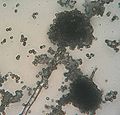Rhizopus
Rhizopus is a genus of common saprophytic fungi, encompassing several species. It is part of the family Rhizopodaceae, and is known for its fast growth and widespread distribution. Rhizopus species are often the first colonizers of organic material, and are important in the decomposition process.
Characteristics[edit]
Rhizopus species are characterized by their hyphae, which are non-septate and coenocytic. They produce sporangia, which are spherical and borne on a columella. The sporangia contain numerous non-motile spores, which are dispersed by wind or water.
Species[edit]
There are several species of Rhizopus, including:
- Rhizopus stolonifer: Also known as the black bread mold, it is a common species that is often used in research.
- Rhizopus oryzae: This species is used in the production of traditional Asian fermented foods.
- Rhizopus microsporus: This species can cause human disease, particularly in immunocompromised individuals.
Pathogenicity[edit]
Some Rhizopus species can cause disease in humans and other animals. The most common disease caused by Rhizopus is mucormycosis, a serious and often fatal fungal infection. Rhizopus infections are particularly dangerous for individuals with weakened immune systems, such as those with HIV/AIDS, cancer, or organ transplant recipients.
Treatment[edit]
Treatment for Rhizopus infections typically involves antifungal medications, such as amphotericin B and posaconazole. In severe cases, surgical debridement of infected tissues may be necessary.
See also[edit]
Ad. Transform your life with W8MD's Budget GLP-1 injections from $75


W8MD offers a medical weight loss program to lose weight in Philadelphia. Our physician-supervised medical weight loss provides:
- Weight loss injections in NYC (generic and brand names):
- Zepbound / Mounjaro, Wegovy / Ozempic, Saxenda
- Most insurances accepted or discounted self-pay rates. We will obtain insurance prior authorizations if needed.
- Generic GLP1 weight loss injections from $75 for the starting dose.
- Also offer prescription weight loss medications including Phentermine, Qsymia, Diethylpropion, Contrave etc.
NYC weight loss doctor appointmentsNYC weight loss doctor appointments
Start your NYC weight loss journey today at our NYC medical weight loss and Philadelphia medical weight loss clinics.
- Call 718-946-5500 to lose weight in NYC or for medical weight loss in Philadelphia 215-676-2334.
- Tags:NYC medical weight loss, Philadelphia lose weight Zepbound NYC, Budget GLP1 weight loss injections, Wegovy Philadelphia, Wegovy NYC, Philadelphia medical weight loss, Brookly weight loss and Wegovy NYC
|
WikiMD's Wellness Encyclopedia |
| Let Food Be Thy Medicine Medicine Thy Food - Hippocrates |
Medical Disclaimer: WikiMD is not a substitute for professional medical advice. The information on WikiMD is provided as an information resource only, may be incorrect, outdated or misleading, and is not to be used or relied on for any diagnostic or treatment purposes. Please consult your health care provider before making any healthcare decisions or for guidance about a specific medical condition. WikiMD expressly disclaims responsibility, and shall have no liability, for any damages, loss, injury, or liability whatsoever suffered as a result of your reliance on the information contained in this site. By visiting this site you agree to the foregoing terms and conditions, which may from time to time be changed or supplemented by WikiMD. If you do not agree to the foregoing terms and conditions, you should not enter or use this site. See full disclaimer.
Credits:Most images are courtesy of Wikimedia commons, and templates, categories Wikipedia, licensed under CC BY SA or similar.
Translate this page: - East Asian
中文,
日本,
한국어,
South Asian
हिन्दी,
தமிழ்,
తెలుగు,
Urdu,
ಕನ್ನಡ,
Southeast Asian
Indonesian,
Vietnamese,
Thai,
မြန်မာဘာသာ,
বাংলা
European
español,
Deutsch,
français,
Greek,
português do Brasil,
polski,
română,
русский,
Nederlands,
norsk,
svenska,
suomi,
Italian
Middle Eastern & African
عربى,
Turkish,
Persian,
Hebrew,
Afrikaans,
isiZulu,
Kiswahili,
Other
Bulgarian,
Hungarian,
Czech,
Swedish,
മലയാളം,
मराठी,
ਪੰਜਾਬੀ,
ગુજરાતી,
Portuguese,
Ukrainian




